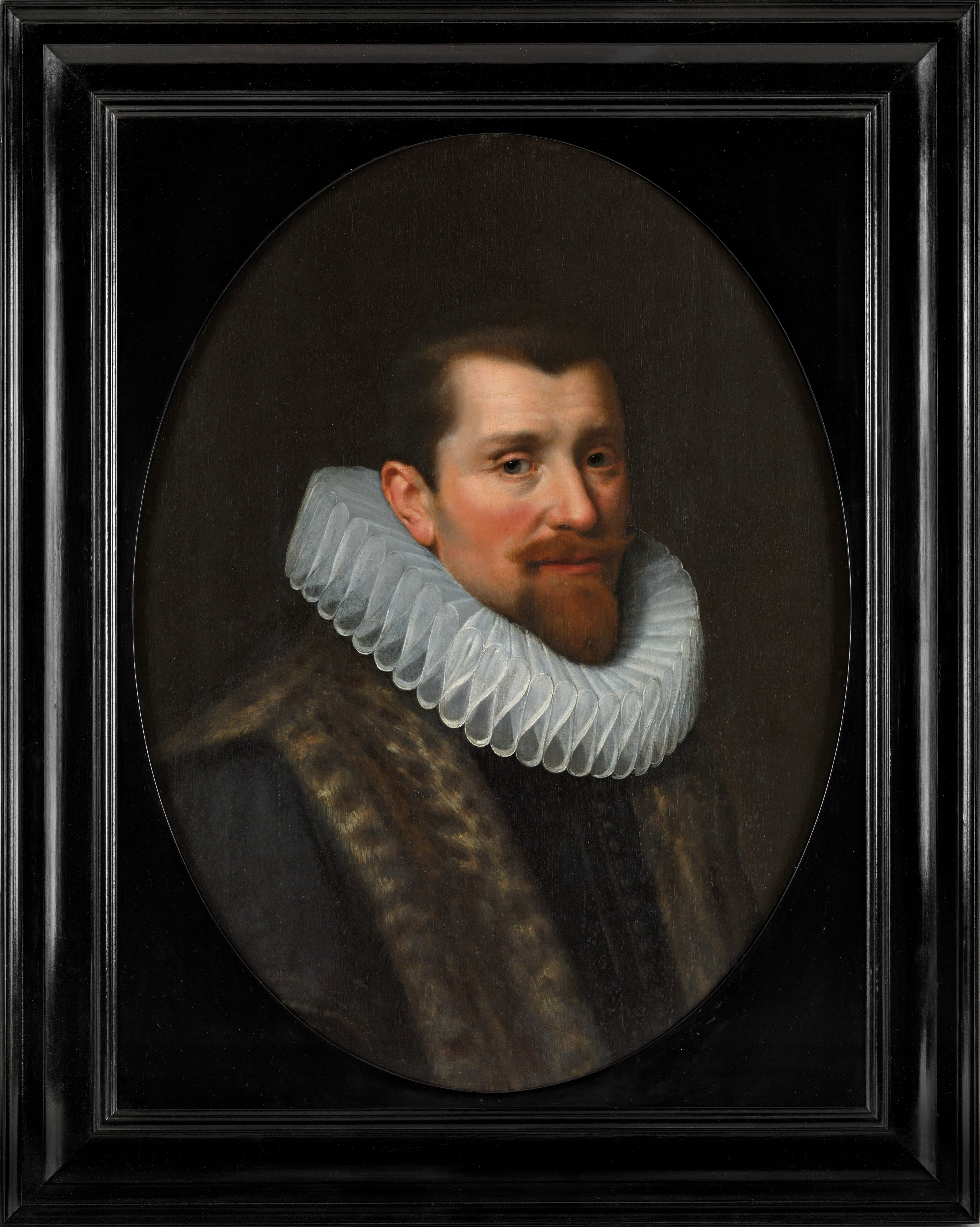Oil on panel
67,5 x 51 cm. each
The man’s portrait by the artist after an anonymous work from 1604.
Art-historical texts and documentation by Rudi Ekkart and Claire van den Donk
Art-historical texts and documentation by Rudi Ekkart and Claire van den Donk
The male sitter is Floris Gerritsz. van Schoterbosch, born in Haarlem ca. 1562. He died in The Hague on 3 October 1618, son of Gerrit van Schoterbosch and Weyntje Pietersdr. Kies. Attorney for the Hof van Holland, counselor in the Hof van Holland 1602-1619. He married Delft (bans 15 September 1602) Geertruyt Jansr. van den Kerckhoven, who died after 1640.
An old and a new likeness
At first glance, the two portraits by the Hague painter Anthonisz. van Ravesteyn appear to form a seamless pair. In reality, however, their origins for their creation are entirely different. Forty years ago, the sitters were identified as Floris Gerritsz. van Schoterbosch (c. 1562- 1618) and his wife, Geertruyt van Kerckhoven (died after 1640).1 The identification was made possible thanks to the existence of another version of Floris’ portrait, created as part of a small family gallery consisting of six portraits. These were painted around 1620 by the Haarlem artist Cornelis Engelsz., and featured depictions of Floris van Schoterbosch’s brother, his father, his grandfather and his two great-grandfathers.2 However, as is the case in the version now at the Argento Gallery, Floris van Schoterbosch had already been long deceased for many years when the artist painted the portrait. According to an inscription, Engelsz. based the image on a much earlier likeness from 1604, which unfortunately appears to have been lost. Thus, the portrait of Floris van Schoterbosch discussed here is actually the second repetition of his likeness and was likely painted in 1639 – 21 years after his death.
This posthumous portrait was paired with the pendant depicting his widow, likely painted from life in the same year, 1639. That year is also featured in an inscription on a second version of her portrait in a rectangular format.3 This suggests that her likeness was specifically commissioned to accompany the image of her late husband, whose original prototype had been executed 35 years earlier. It is possible that the original 1604 portrait of the man was also painted by Jan Anthonisz. van Ravesteyn, who painted the two oval portraits currently under discussion.
The pair was passed down through a daughter of the sitters and remained in the family until it eventually surfaced on the art market in the early twentieth century.
A personal note from the gallery
‘The story behind these portraits is extraordinary. She had herself painted with her husband even though he had been gone for years. That kind of love and devotion is moving. What makes them even more special is that they were painted by Jan Anthonisz. van Ravesteyn, one of the great portraitists of The Hague, whose clients included the stadholder’s court and the city’s most powerful families. To have not only the painter, but also the sitters fully identified, is rare in seventeenth-century portraiture. Here, the names, the faces, and the love story all come together: a complete picture that brings the past vividly into the present.’
Jaco Pieper, owner Argento Gallery
Provenance
Inherited via the daughter of the sitters, Catharina Overrijn van Schoterbosch (1608-1679), wife of Philips Doubleth (c. 1605-1674), city council, alderman and burgomaster of The Hague; inherited via their son François Doubleth (1642-1688), grandson François Doubleth (1688-1725) and great-grandson François Doubleth (1715-1769); passed down in 1765 with the house Hof van Moerkerken in 1765 to Arij de Coningh (1712-1784) and subsequently to his son Assendelft de Coningh (1747-1803) and daughter-in-law Cornelia Theodora van der Houven (1771-1863); inherited after their death by their daughter Elisabeth van Assendelft de Coningh (1798-1880), wife of Arnoldus van Gennep, and subsequently by their son Jan van Gennep (1830-1911); purchased after his death by J. Goudstikker Gallery in Amsterdam (exh. cat. IX, The Hague, October 1918, nos. 47 and 48; exh. cat. X, Amsterdam, November-December 1918, nos. 51 and 52, as portraits of members of the Doubleth family); Collection E.M. Ostwalt, Amsterdam; J. Goudstikker Gallery, Amsterdam (exh. cat. Copenhagen, 1922, nos. 103 and 104; exh. cat. XXII, The Hague, November 1922, nos. 79 and 80); Douwes Gallery, Amsterdam, 1933 (inv. no. 6021); P. de Boer Gallery, Amsterdam (exh. cat. Summer 1941, nos. 18 and 19, ill.); Collection Cornelius Dekker, Wassenaar, 1943; his heirs.
Notes
1. Rudi Ekkart, ‘Portretten van Johan Schoterbosch’, in: Liber Amicorum Khr. Mr. C.C. van Valkenburg, The Hague (Centraal Bureau voor Genealogie; CBG) 1985, pp. 103-110.
2. The version in the family series (panel, 38,8 x 29 cm.) housed – along with the rest of the series – in the collection of the Rijksmuseum in Amsterdam (inv. nr. SK-A-4775), depicts Floris van Schoterbosch in half-length. In the 1985 publication referenced in note 1, the images of Floris and his slightly younger brother Johan van Schoterbosch (illustrations 7 and 8) were mistakenly reversed, further complicating the already complex matter.
3. Panel, 68,5 x 51 cm. In 1903 in the possession of Uitgeverij Martinus Nijhoff and featured in the portrait exhibition held in that year. See: Cornelis Hofstede de Groot, Meisterwerke der Porträtmalerei auf der Ausstellung im Haag 1903, Munich 1903, no. 109a and plate 47.




